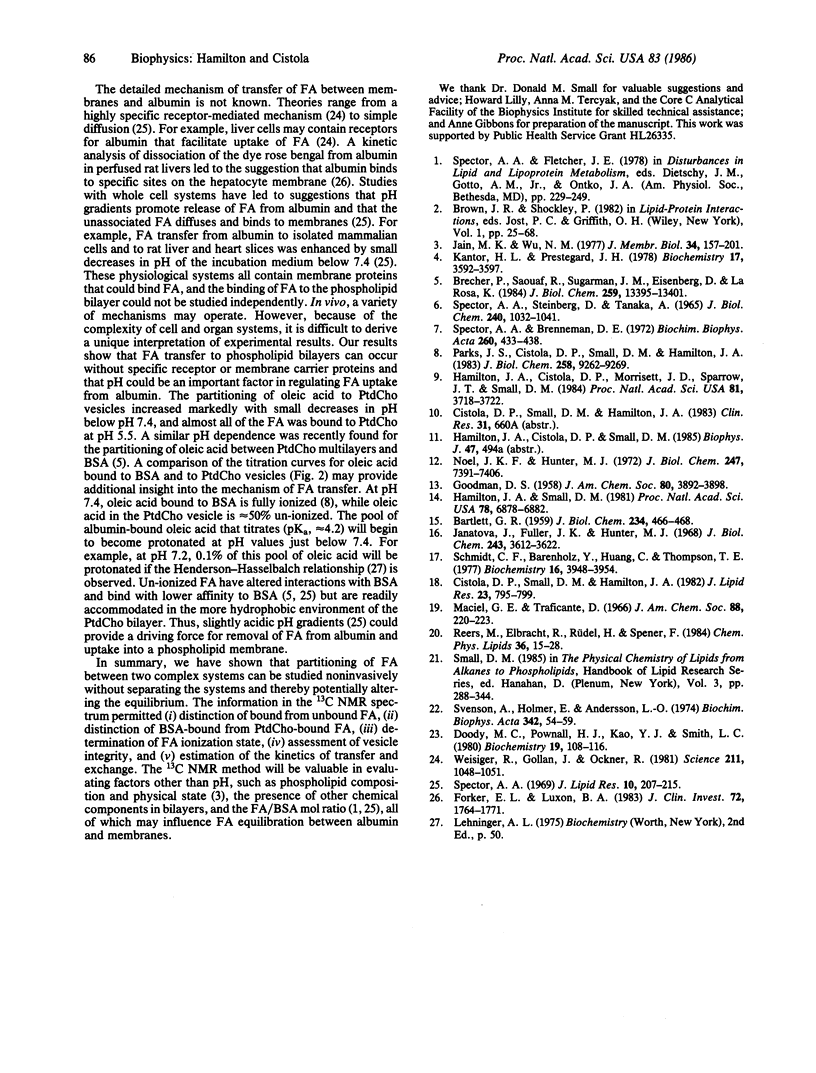Abstract
The net transfer of oleic acid between egg phosphatidylcholine unilamellar vesicles and bovine serum albumin has been monitored by 13C NMR spectroscopy and 90% isotopically substituted [1-13C]oleic acid. The carboxyl chemical shifts of oleic acid bound to albumin were different from those for oleic acid in phospholipid vesicles. Therefore, in mixtures of donor particles (vesicles or albumin with oleic acid) and acceptor particles (fatty acid-free albumin or vesicles), the equilibrium distribution of oleic acid was determined from chemical shift and peak intensity data without separation of donor and acceptor particles. In a system containing equal masses of albumin and phospholipid and a stoichiometry of 4-5 mol of oleic acid per mol of albumin, the oleic acid distribution was pH dependent, with greater than or equal to 80% of the oleic acid associated with albumin at pH 7.4; association was greater than or equal to 90% at pH 8.0. Decreasing the pH below 7.4 markedly decreased the proportion of fatty acid bound to albumin; at pH 5.4, less than or equal to 10% of the oleic acid was bound to albumin and greater than 90% was associated with vesicles. The distribution was reversible with pH and was independent of whether vesicles or albumin acted as a donor. These data suggest that pH may strongly influence the partitioning of fatty acid between cellular membranes and albumin. The 13C NMR method is also advantageous because it provides information about the structural environments of oleic acid bound to albumin or phospholipid, the ionization state of oleic acid in each environment, and the structural integrity of the vesicles. In addition, minimum and maximum limits for the exchange rates of oleic acid among different environments were obtained from the NMR data.
Full text
PDF




Selected References
These references are in PubMed. This may not be the complete list of references from this article.
- BARTLETT G. R. Phosphorus assay in column chromatography. J Biol Chem. 1959 Mar;234(3):466–468. [PubMed] [Google Scholar]
- Brecher P., Saouaf R., Sugarman J. M., Eisenberg D., LaRosa K. Fatty acid transfer between multilamellar liposomes and fatty acid-binding proteins. J Biol Chem. 1984 Nov 10;259(21):13395–13401. [PubMed] [Google Scholar]
- Cistola D. P., Small D. M., Hamilton J. A. Ionization behavior of aqueous short-chain carboxylic acids: a carbon-13 NMR study. J Lipid Res. 1982 Jul;23(5):795–799. [PubMed] [Google Scholar]
- Doody M. C., Pownall H. J., Kao Y. J., Smith L. C. Mechanism and kinetics of transfer of a fluorescent fatty acid between single-walled phosphatidylcholine vesicles. Biochemistry. 1980 Jan 8;19(1):108–116. doi: 10.1021/bi00542a017. [DOI] [PubMed] [Google Scholar]
- Forker E. L., Luxon B. A. Albumin-mediated transport of rose bengal by perfused rat liver. Kinetics of the reaction at the cell surface. J Clin Invest. 1983 Nov;72(5):1764–1771. doi: 10.1172/JCI111136. [DOI] [PMC free article] [PubMed] [Google Scholar]
- Hamilton J. A., Cistola D. P., Morrisett J. D., Sparrow J. T., Small D. M. Interactions of myristic acid with bovine serum albumin: a 13C NMR study. Proc Natl Acad Sci U S A. 1984 Jun;81(12):3718–3722. doi: 10.1073/pnas.81.12.3718. [DOI] [PMC free article] [PubMed] [Google Scholar]
- Hamilton J. A., Small D. M. Solubilization and localization of triolein in phosphatidylcholine bilayers: a 13C NMR study. Proc Natl Acad Sci U S A. 1981 Nov;78(11):6878–6882. doi: 10.1073/pnas.78.11.6878. [DOI] [PMC free article] [PubMed] [Google Scholar]
- Hariharan P. P., Cerutti P. A. Repair of gamma-ray-induced thymine damage in Micrococcus radiodurans. Nat New Biol. 1971 Feb 24;229(8):247–249. doi: 10.1038/newbio229247a0. [DOI] [PubMed] [Google Scholar]
- Janatova J., Fuller J. K., Hunter M. J. The heterogeneity of bovine albumin with respect to sulfhydryl and dimer content. J Biol Chem. 1968 Jul 10;243(13):3612–3622. [PubMed] [Google Scholar]
- Kantor H. L., Prestegard J. H. Fusion of phosphatidylcholine bilayer vesicles: role of free fatty acid. Biochemistry. 1978 Aug 22;17(17):3592–3597. doi: 10.1021/bi00610a027. [DOI] [PubMed] [Google Scholar]
- Noel J. K., Hunter M. J. Bovine mercaptalbumin and non-mercaptalbumin monomers. Interconversions and structural differences. J Biol Chem. 1972 Nov 25;247(22):7391–7406. [PubMed] [Google Scholar]
- Parks J. S., Cistola D. P., Small D. M., Hamilton J. A. Interactions of the carboxyl group of oleic acid with bovine serum albumin: a 13C NMR study. J Biol Chem. 1983 Aug 10;258(15):9262–9269. [PubMed] [Google Scholar]
- SPECTOR A. A., STEINBERG D., TANAKA A. UPTAKE OF FREE FATTY ACIDS BY EHRLICH ASCITES TUMOR CELLS. J Biol Chem. 1965 Mar;240:1032–1041. [PubMed] [Google Scholar]
- Schmidt C. F., Barenholz Y., Huang C., Thompson T. E. Phosphatidylcholine 13C-labeled carbonyls as a probe of bilayer structure. Biochemistry. 1977 Sep 6;16(18):3948–3954. doi: 10.1021/bi00637a002. [DOI] [PubMed] [Google Scholar]
- Spector A. A., Brenneman D. E. Effect of free fatty acid structure on binding to rat liver mitochondria. Biochim Biophys Acta. 1972 Mar 23;260(3):433–438. doi: 10.1016/0005-2760(72)90058-6. [DOI] [PubMed] [Google Scholar]
- Spector A. A. Influence of pH of the medium on free fatty acid utilization by isolated mammalian cells. J Lipid Res. 1969 Mar;10(2):207–215. [PubMed] [Google Scholar]
- Svenson A., Holmer E., Andersson L. O. A new method for the measurement of dissociation rates for complexes between small ligands and proteins as applied to the palmitate and bilirubin complexes with serum albumin. Biochim Biophys Acta. 1974 Mar 14;342(1):54–59. doi: 10.1016/0005-2795(74)90105-6. [DOI] [PubMed] [Google Scholar]
- Weisiger R., Gollan J., Ockner R. Receptor for albumin on the liver cell surface may mediate uptake of fatty acids and other albumin-bound substances. Science. 1981 Mar 6;211(4486):1048–1051. doi: 10.1126/science.6258226. [DOI] [PubMed] [Google Scholar]


